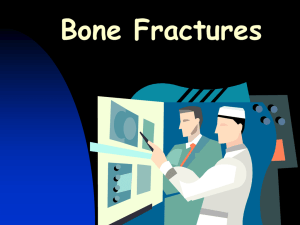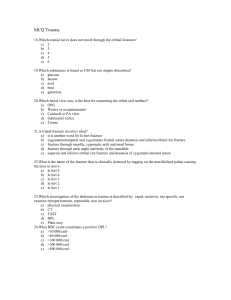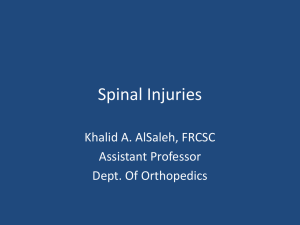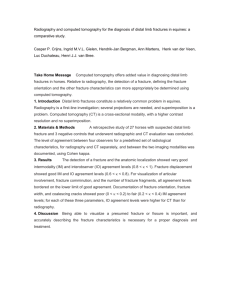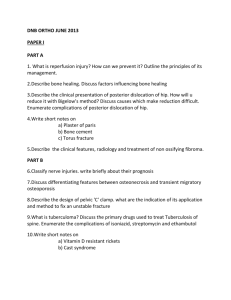EMERGENGY & TRAUMA RADIOLOGY
advertisement
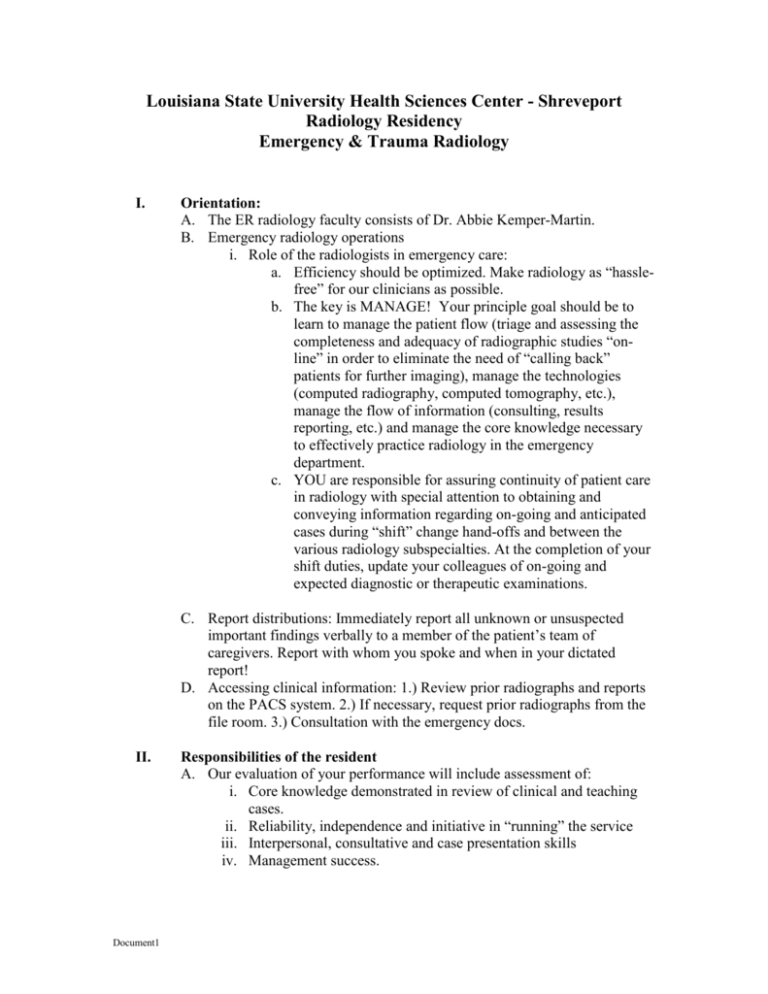
Louisiana State University Health Sciences Center - Shreveport Radiology Residency Emergency & Trauma Radiology I. Orientation: A. The ER radiology faculty consists of Dr. Abbie Kemper-Martin. B. Emergency radiology operations i. Role of the radiologists in emergency care: a. Efficiency should be optimized. Make radiology as “hasslefree” for our clinicians as possible. b. The key is MANAGE! Your principle goal should be to learn to manage the patient flow (triage and assessing the completeness and adequacy of radiographic studies “online” in order to eliminate the need of “calling back” patients for further imaging), manage the technologies (computed radiography, computed tomography, etc.), manage the flow of information (consulting, results reporting, etc.) and manage the core knowledge necessary to effectively practice radiology in the emergency department. c. YOU are responsible for assuring continuity of patient care in radiology with special attention to obtaining and conveying information regarding on-going and anticipated cases during “shift” change hand-offs and between the various radiology subspecialties. At the completion of your shift duties, update your colleagues of on-going and expected diagnostic or therapeutic examinations. C. Report distributions: Immediately report all unknown or unsuspected important findings verbally to a member of the patient’s team of caregivers. Report with whom you spoke and when in your dictated report! D. Accessing clinical information: 1.) Review prior radiographs and reports on the PACS system. 2.) If necessary, request prior radiographs from the file room. 3.) Consultation with the emergency docs. II. Document1 Responsibilities of the resident A. Our evaluation of your performance will include assessment of: i. Core knowledge demonstrated in review of clinical and teaching cases. ii. Reliability, independence and initiative in “running” the service iii. Interpersonal, consultative and case presentation skills iv. Management success. B. Service hours and educational format. i. Monday – Friday: 08:00a.m. to 04:00 p.m. ii. Most instruction will be performed on a one-on-one basis between the emergency radiology staff and the resident. iii. Either the emergency radiology staff or the appropriate resident will present a monthly interesting case/missed case conference for the department. iv. The emergency staff on a monthly basis will provide teaching conferences. v. Residents are to attend all scheduled departmental conferences. vi. Residents are encouraged to spend time with the technical staff to learn radiographic positioning of the projections included in our most commonly requested conventional radiographs and in the most common CT studies. C. Reading: i. Main text: Stern – Trauma Radiology Companion ii. Selected chapters in supplemental texts. (Rogers – Radiology of Skeletal Trauma; Harris & Harris – The Radiology of Emergency Medicine; Osborn – Diagnostic Neuroradiology) Educational Goals and Objectives: First and Second Year Radiology Residents (PGY 2 – 3) Patient Care: Participate in the real-time integration of clinical and imaging data in the formation of the treatment plan. Before the junior resident begins to take overnight call, they must be prepared to develop a patient management plan based upon available information (including radiography, ultrasound, CT, MRI). The assimilation of information from electronic reporting databases is an essential component of this process. 3) Counsel patients concerning exam preparations. 4) Perform exams responsibly and safely, assuring that the correct exam is ordered and performed. 5) Demonstrate exam specific radiation doses and ALARA 6) Oversee customized imaging workups. Document1 Medical Knowledge: By the completion of the first year, residents are expected to demonstrate knowledge of normal anatomy and recognition of abnormal imaging findings in life-threatening or unstable conditions, such as: * Cervical spine, pelvic and extremity fractures * Pneumothorax * Free fluid within the abdomen * Signs of active bleeding * Acute intracranial hemorrhage and cerebrovascular accident (CVA) * Common causes of non-traumatic acute abdominal pain (e.g. appendicitis, diverticulitis) * Pulmonary embolism in uncomplicated cases 2) Demonstrate understanding of the principles of research project design and implementation . 3) Demonstrate a clinically appropriate diagnostic treatment plan. 4) Demonstrate the ability to use all relevant information resources to acquire evidence based data. 5) Demonstrate the proper use of radiological equipment. Interpersonal and Communication Skills: The resident must be directly available at all times while assigned to the ED. Absences from the reading room should be coordinated with the attending radiologist or other resident to the ED. All residents rotating through the ED are expected to appropriately communicate and document in the patient record urgent or unexpected radiologic findings. The resident is expected to communicate discrepancy reports and alterations between preliminary (i.e. resident) and final (i.e. attending) interpretations according to department protocol. Produce radiologic reports that are accurate, concise and grammatically correct. Communicate effectively with all members of the health care team. 6) Demonstrate skills in obtaining informed consent, including effective communication to patients of the procedure, alternatives, and possible complications. 7) Demonstrate the verbal and non-verbal skills necessary for face to face listening and speaking to physicians, families, and support personnel. Document1 Practice-Based Learning and Improvement: The resident assigned to the ED is expected to: * Identify, rectify and learn from personal errors. * Efficiently use electronic and print resources to access information. The resident is both asked to and expected to utilize access to on-line informational databases, as well as appropriate textbooks to expand their fund-of-knowledge in as close to a real-time manner as possible whenever confronted by unfamiliar diagnoses or entities. 2) Help teaching of medical students, peers and other health care professionals. Professionalism: The resident assigned to the ED is expected to: * Demonstrate respect for patients and all members of the health care team * Respect patient confidentiality * Present oneself as a professional in appearance and communication * Demonstrate a responsible work ethic with regard to work assignments * Place the interest of the patient first and appropriately consult attending radiologist on call when necessary for assistance 2) Demonstrate sensitivity without prejudice on the basis of religious, ethnic, sexual or educational differences, and without employing sexual or other types of harassment. 3) Demonstrate knowledge of issues of impairment Systems-Based Practice: Demonstrate knowledge of how radiologic information is integrated with the other parts of the health care system in the treatment of the patient. The radiologist, as a member of both the Department of Diagnostic Imaging and the Emergency Department, is in a unique position to help patients and clinicians navigate through the complexities of both areas. Demonstrate knowledge of trauma imaging protocols. 3) Demonstrate ability to design cost-effective care plans 4) Demonstrate knowledge of funding sources 5) Demonstrate knowledge of reimbursement methods Document1 Third Year Residents (PGY 4) In addition to those listed for second year residents, third year radiology residents have the following objectives: Patient care: Integrate clinical history and imaging findings to provide a diagnosis or an appropriate differential diagnosis. Provide an appropriate management plan for the patient based upon the above. Medical Knowledge: Further refinement of observational abilities and knowledge base with application into an appropriate differential diagnosis of: * Bowel disorders (e.g. ischemia vs. infection vs. neoplasm) * Focal diseases of solid organs * Focal brain lesions * Secondary signs of CVA and herniation * Diffuse and focal lung diseases Knowledge of classification systems for: * Solid organ injury * Facial fractures * Pelvic fractures * Cervical spine fractures Imaging protocols for trauma Interpersonal and Communication Skills: Teach first year residents and medical students emergency radiology Provide consultation on imaging findings to emergency department staff Practice-based Learning and Improvement: Identify, rectify and learn from personal errors Efficiently use electronic and print resources to access information. The resident is both asked to and expected to utilize access to on-line informational databases as well as textbooks to expand their fund of knowledge in as close to a real-time manner as possible whenever confronted by unfamiliar diagnoses or entities. Document1 Professionalism: Act as a role model for medical students and junior residents. 2) Demonstrate altruism 3) Demonstrate the broad principles of biomedical ethics 4) Demonstrate principles of confidentiality with all information transmitted during a patient encounter. Systems-Based Practice: Demonstrate knowledge of cost-effective imaging evaluation in the emergency Department. 2) Demonstrate knowledge of the regulatory environment 3) Demonstrate knowledge of basic management principles such as budgeting, record keeping, medical records, and the recruitment, hiring, supervision and management of staff Fourth Year Residents (PGY 5) In addition to those listed for third year residents, fourth year radiology residents have the following objectives: Patient Care: Demonstrate knowledge of medical and surgical treatment of diseases and how treatment options may guide imaging. Medical Knowledge: Further refinement of detection abilities in subtle or complex cases. 2) Master your radiology knowledge in preparation for the boards and your practice. Interpersonal and Communication Skills: Function independently as a consultant to the emergency department attending staff. Document1 Practice-based Learning and Improvement: Identify, rectify and learn from personal errors. 2) Efficiently use electronic and print resources to access information. The resident is both asked to and expected to utilize access to on-line informational databases as well as textbooks to expand their fund of knowledge in as close to a real-time manner as possible whenever confronted by unfamiliar diagnoses or entities. 3) Demonstrate critical assessment of the scientific literature. 4) Help teaching of medical students, peers and other health care professionals. Professionalism: Demonstrate respect for patients and all members of the health care team Respect patient confidentiality Present oneself as a professional in appearance and communication. Demonstrate a responsible work ethic with regard to work assignments 5) Demonstrate honor and integrity: avoid conflict of interests when accepting gifts from patients and vendors. Systems-Based Practice: Demonstrate knowledge of cost-effective imaging evaluation in the emergency Department. 2) Demonstrate knowledge of basic management principles such as budgeting, record keeping, medical records, and the recruitment, hiring, supervision and management of staff. Resident Evaluation: 1. The monthly electronic rotation evaluation form will be completed by the attending radiologists who have had interaction with the resident. 2. 6 Month evaluation reviewed with the Program Director. 3. OSCE twice per year. 4. ACR In-Service exam 5. ABR Board exams Document1 CURRICULUM I. The Brain and Spine Cerebral Contusion Diffuse Axonal Injury Epidural Hematoma/Hyperacute Intracranial Hemorrhage Acute Subdural Hematoma Chronic Subdural Hematoma/Acute Rehemorrhage Linear Skull Fracture Depressed Skull Fracture Delayed Post-traumatic Intracranial Hemorrhage Child Abuse Gunshot Wound to the Head Acute Dissection: Internal Carotid Artery Acute Intracranial Hemorrhage: Intraventricular Hemorrhage Acute Intracranial Hemorrhage: Subarachnoid Hemorrhage Nontrauma/Nonhemorrhage: Diffuse Anoxic Changes Herniation: Uncal Herniation: Subfalcine Herniation: Upward (Cerebellar Hemorrhage) Facial Trauma: Orbital Floor Fracture Facial Trauma: Tripod Fracture Facial Trauma: LeFort Fracture Cervical Spine Injury: Dens Fracture Cervical Spine Injury: Jefferson Fracture Cervical Spine Injury: Atlanto-Occipital Dissociation Cervical Spine Injury: Transverse Atlantal Ligament Injury Cervical Spine Injury: Traumatic Spondylolisthesis of the Axis Cervical Spine Injury: Hyperflexion Fracture/Burst Fracture Cervical Spine Injury: Unilateral Overriding Facet Cervical Spine Injury: Bilateral Overriding Facet Thoracic/Lumbar Spine Injury: Burst Fracture Thoracic/Lumbar Spine Injury: Flexion/Distraction Fracture Thoracic/Lumbar Spine Injury: Extension/Distraction Fracture II. The Torso Scapulothoracic Dissociation Scapula Fracture Rib Fractures Sternoclavicular Dislocation Sternal & Manubrial Fractures Airway Rupture/Laceration Esophageal Rupture/Laceration Esophageal Intubation with Gastric Perforation Document1 Traumatic Aortic Injury: Chest Radiography Traumatic Aortic Injury: Computed Tomography Injury to the Brachiocephalic Vessels Myocardial Contusion Cardiac Perforation and Rupture Acute Traumatic Hemopericardium Hemidiaphragm Injury Pulmonary Contusion Pulmonary Laceration Pulmonary Laceration: Traumatic Pneumatocele Pulmonary Laceration: Pulmonary Hematoma Lung Injury: Blast Effect Barotrauma Aspiration of Foreign Body Near Drowning Intraperitoneal Fluid in Trauma Extraperitoneal Fluid in Trauma Intraperitoneal and Retroperitoneal Gas Active Bleeding: Findings on CT Scan Liver Injury Biliary Injury Splenic Trauma Pancreatic Injury Gastrointestinal and Mesenteric Injury Duodenal Injury Extraperitoneal Colonic Injury Adrenal Hemorrhage Renal Injury Renal Laceration with Urinary Extravasation Ureteral Injury Bladder Injury: Intraperitoneal Rupture Bladder Injury: Extraperitoneal Rupture Urethral Injury Trauma to the Gravid Uterus Testicular Trauma III. Upper Extremity Clavicle Fractures Acromio-clavicular Joint Dislocation Shoulder Joint Dislocation Humeral Fractures Epicondyle Injury Elbow Dislocation Radial Head Fractures Radius and Ulna Shaft Fractures Carpal Fractures Document1 Carpal Dislocations Metacarpal Fractures Phalangeal Fractures IV. Pelvis/Lower Extremity Pelvis Apophyseal Avulsions Lateral Compression Pelvic Fracture Anterior Compression Pelvic Fracture Vertical Shear Pelvic Fracture Pelvic Ring Disruption and Arterial Injury Sacral Fracture Anterior Hip Dislocation Posterior Hip Dislocation Posterior Wall Acetabular Fracture Transverse Acetabular Fracture Both Column Acetabular Fracture Intracapsular Femoral Neck Fracture Occult Hip Fracture Stress-Insufficiency Fracture of the Femoral Neck Intertrochanteric Femur Fracture Subtrochanteric Femur Fracture Femoral Shaft Fracture Supracondylar Fracture of the Femur Patella Fracture Tibial Plateau Fracture Tibial Spine (Anterior Cruciate) Avulsions Avulsion of the Posterior Cruciate Ligament Insertion Segond Fracture Patellar Dislocation Knee Dislocation Tibial and Fibular Shaft Fractures Tibial Stress Fracture Tibial Plafond Fracture Ankle Mortise Injuries Cuneiform Fracture Calcaneal Fracture Talus Fracture Talar and Subtalar Dislocations Tarsal Navicular Fracture The Nutcracker Fracture of the Cuboid Lisfranc’s Fracture Dislocation Metatarsal Fracture Toe Injuries Document1 EMERGENCY/TRAUMA RADIOLOGY EXPECTATIONS 1ST year: - learn how to manage the emergency radiology section in preparation for call. e.g. how to triage studies appropriately when resources become limited, how to obtain and relay information to the ordering clinicians, - learn what views of the most commonly ordered exams constitute a normal study. e.g. spines, cxr, abdomen, pelvis, extremities - begin to recognize pathology and learn appropriate descriptive terms for dictation purposes. 2nd year: - to become more proficient in the above tasks. - to be able to recognize more subtle patterns of injury. 3rd year: - to have reviewed either in actual practice in the ER, from teaching files or texts each of the curriculum cases listed in the attached guide. 4th year: - to demonstrate independence and accuracy in reading films and managing the ER section. - to obtain an understanding of the pathophysiology of trauma and how it relates to imaging findings. EMERGENCY RADIOLOGY ROTATION 1: Knowledge based objectives – at the end of the rotation the resident should be able to: 1. Identify normal anatomy of the bones, chest, abdomen and pelvis as seen on CT and plain film. 2. Identify and describe common variants of normal. 3. Demonstrate a basic knowledge of radiologic interpretation as it relates to emergency radiology. Technical skills – at the end of the rotation the resident should be able to: 1. Given a chest, abdomen, bone or pelvis film or CT distinguish normal from abnormal structures. 2. Dictate a report that is brief and understandable. 3. Communicate verbally with the referring physician and house staff about radiographic findings. Document1 Decision-making and value judgment – at the end of the rotation the resident should be able to: 1. Make decisions about when to alert the house staff to the immediacy of a condition that is apparent on the radiograph. 2. Determine when to request that a repeat exam is needed because of technical inadequacy. ROTATION 2: Knowledge based objectives – at the end of the rotation the resident should be able to: 1. Discuss various common fracture patterns and acute conditions of the chest. 2. Discuss the most commonly encountered acute abnormalities of the chest, abdomen and pelvis as seen on cross sectional images. Technical skills – at the end of the rotation the resident should be able to: 1. Recognize and describe the most commonly encountered acute abnormalities on plain film and CT. 2. Dictate with clarity and accuracy more complicated reports. Decision-making and value judgment – at the end of the rotation the resident should be able to: 1. Determine which cases can be interpreted and dictated independently and which cases require the assistance of a faculty radiologist. ROTATION 3: Knowledge based objectives – at the end of the rotation the resident should be able to: 1. Discuss the mechanisms of injury and commonly associated injury patterns seen in the multi-trauma patient. 2. Correlate clinical data with radiological findings. Technical skills – at the end of the rotation the resident should be able to: 1. Read routine ER films with a high level of accuracy and efficiency. 2. Supervise the performance of emergency CT scans. 3. Perform and interpret emergency ultrasound exams. Decision-making and value judgment – at the end of the rotation the resident should be able to: 1. Demonstrate a high degree of accuracy in interpreting and dictating cases, identifying those cases with which assistance is needed. 2. Consult, with confidence, with primary care physicians and surgeons in regard to most emergently obtained imaging procedures. Document1 References: Association of Program Directors in Radiology (www.apdr.org) Tampa General Hospital, ER Dept. Goals Emergency Radiology Core Lectures: Abbie Kemper-Martin, M.D. 1 2 3 4 5 6 7 8 9 10 Emergency Radiology operations Brain trauma Spinal trauma Fractures and dislocations Chest trauma Gastrointestinal emergencies Genitourinary emergencies Vascular emergencies Pelvic emergencies Pediatric emergencies Document1

